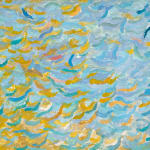George Claessen
Blue Motet, 1969
Oil on canvas
71.1 x 91.4 cm
28 x 36 in
28 x 36 in
Signed and dated 'CLAESSEN 69' lower right
Further images
One might categorize Claessen's printings by reference to French tachism, or to the kind of American abstract expressionism exemplified by Rothko; but to do so would he to move entirely...
One might categorize Claessen's printings by reference to French tachism, or to the kind of American abstract expressionism exemplified by Rothko; but to do so would he to move entirely in the wrong direction. There is nothing accidental in the evolution of Claesen's luminous mists; and there is very little that is either environmental or specifically emotional.
They are, instead, quintessentially calm, deliberate, contemplative. If ever there were paintings whose light shines through contact with the inner light of a man at peace with himself, these are they. They are not professional but confessional.
It has been said of these pictures that "there is nothing there". This is probably so, but it is so, in the sense that the mystic reality of Nothing is precisely their subject. They are not figurative; but neither are they abstract (in the ways we usually understand this term ). They are precise renditions, with the utmost reality, of that state of Being which is beyond Appearance.
They are pointers to the imperium of God, to that world some call the Undifferentiated Continuum. It does not matter that sometimes a stroke of colour is, aesthetically, not where the eye of perception says it should be; but it does not matter that nothing perfect, nothing complete in itself, really requires the inner eye's response.
Perhaps a painting is no more able to elicit such a response than any other worldly happening: but it cannot be less then n mark of the utmost simplicity, of utter humility, of the deepest conviction, for a painter to reach no uncompromisingly toward the unreachable.
G.M. Butcher, 1957
They are, instead, quintessentially calm, deliberate, contemplative. If ever there were paintings whose light shines through contact with the inner light of a man at peace with himself, these are they. They are not professional but confessional.
It has been said of these pictures that "there is nothing there". This is probably so, but it is so, in the sense that the mystic reality of Nothing is precisely their subject. They are not figurative; but neither are they abstract (in the ways we usually understand this term ). They are precise renditions, with the utmost reality, of that state of Being which is beyond Appearance.
They are pointers to the imperium of God, to that world some call the Undifferentiated Continuum. It does not matter that sometimes a stroke of colour is, aesthetically, not where the eye of perception says it should be; but it does not matter that nothing perfect, nothing complete in itself, really requires the inner eye's response.
Perhaps a painting is no more able to elicit such a response than any other worldly happening: but it cannot be less then n mark of the utmost simplicity, of utter humility, of the deepest conviction, for a painter to reach no uncompromisingly toward the unreachable.
G.M. Butcher, 1957
Provenance
Collection of the Artist;Mrs. E.B. Payne, London;
Estate of the Artist, gifted by the above
Exhibitions
London, Phillips X & Grosvenor Gallery, Crossing Borders: Modern Art from South Asia, 10 - 31 July 2025, (illustrated in the exhibition catalogue)London, Stanhope Gallery, Exhibition of Paintings & Graphics by George Claessen, 20 - 31 October, 1975, No. 1





